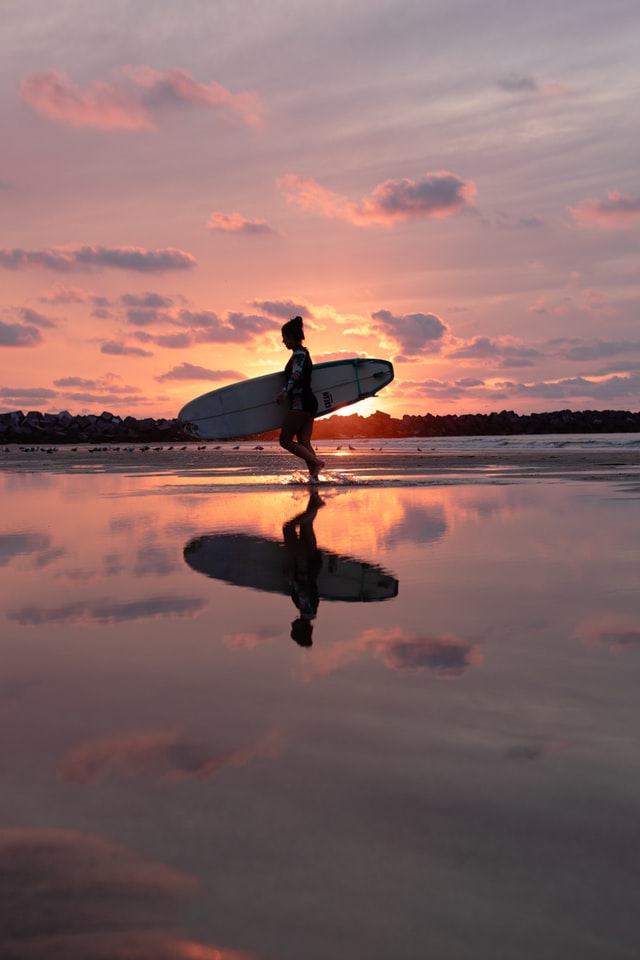I first surfed in Sri Lanka in January 2020, where I spent three days with a hipster surf instructor before I went off to surf solo.
I had to wait another 20 months to enjoy this thrilling activity.
This time, the surf location was a little closer to home in Madeira, the Portuguese island off the coast of Africa. As I surfed in October 2021, I smiled as all the feelings came flooding back.
It is so hard to explain what I feel when I surf so instead I have captured what I have learned in the hope this may nudge you to try this enthralling experience.
There are so many lessons which apply to life—enjoy.
1. Don’t take notice of a label or you will miss out on some epic experiences.
As you embark on a new activity, you are moving out your comfort zone. This will trigger your inner critic. You will probably hear, quite loudly, internal narrative like, “I’m not a surf girl.” Our thinking is conditioned based on what floods our minds. Our minds, based on society, are flooded with images of what a surf girl looks like. From movies, magazines, and social media.
Does this stereotype sound familiar? A surfer girl appears with long, blond, wavy hair, a slender body, and she surfs most weekends in Hawaii.
That is old news. As, spoiler alert, back in the real world—year 2021—a surfer girl can be anyone and everyone. Cue, round of applause.
Think of yourself as a pear and the typical Hawaii surfer girl as a banana. You are both fruits from a fruit bowl. Different on the surface, but both with a common connection. Anyone in the fruit bowl can surf. Hurray. Even oranges. So, look around and smile as you notice the fruit salad of surfers chasing the waves and quiet your stereotype-obsessed inner critic.
2. Be comfortable as a beginner—embrace it all.
Sometimes in life, we need to let go of the perfect expectation created in our minds and go with the flow. Fully embrace the learning curve.
Learning any new skill, or activity, can feel overwhelming as we are expecting an outcome. We want to jump from “never tried” novice to an expert within minutes, bypassing the “looking clumsy” stage. We need to remind ourselves of children when they start to crawl then walk. They wobble and flop, crash and fall over. Each time learning a little more, each time gaining more confidence. Then, in between moments of looking clumsy, they suddenly stand up and walk around, unassisted, with a gleeful look on their face. Of course, still with regular wobbles and bumps.
Each time I surf, I know I will stumble back up from another crash, and I make sure I laugh at myself! We live and learn. Spoiler: no one is watching you, so don’t worry about how ridiculous you look—crash away.
3. Be a sponge. Listen and watch. Try and learn.
Let’s think of children learning to walk again. They are little sponges. They watch others around them glide past; that is their target. They also use support, the furniture, to guide their progress. Sometimes they sit down to recharge their energy, then they go again. And that is exactly what mindset you need to take to learn to surf.
Watch other surfers and other beginners. Listen to your instructor; they are there to support and guide your performance. Dissect your own performance. What small changes can you make between each surf attempt? See it as a game, where your mind and body are open to learn and adapt. Trial and error, slowly progressing into the true surfer you could become.
4. Don’t overthink it. Flow.
Don’t allow the self-doubt (that lives in us all) hold you back. In adult life, we like to live in the future; we are predicting the outcome of the next surf attempt before we’ve even spotted a wave to ride. The feeling when you judge the incoming wave, jump up, and stand surfing the wave is intense. That feeling is something else.
Free yourself and have the most amazing experience. Don’t overthink each component or part of how to catch a wave; instead, breath and flow into it. Tell yourself, “Ready, you’ve got this,” then go for it.
My instructor would look me in the eye and ask, “Ready?” At first, I said, “No.” He would reply, “Don’t think, just move with the wave.” By the end of my session I would reply “yes” to that “ready?” question.
It shifts your mind to control the outcome, rather than let the wave control you. Set up your mindset with positive self-talk, relax, and flow.
5. Store that feeling; it will keep you coming back.
That feeling of accomplishment, achieving something that was once seemingly impossible, is why we try new stuff. Remember that quote, “But darling, what if you fly?” When you finally catch a wave, it feels epic. Your body, mind, and nature in unison. You feel like you are flying.
I heard my instructor mumble “30 minutes left” and I got going in a loop: attempt to surf, surf or crash, get back out there, go again. Control the normal feelings of frustration, and, at times, exhaustion. Regardless if I caught a wave or not, I would swim back out to go again. Each time in my mind chasing the feeling of accomplishment—a natural “surfer’s high.”
6. Progress not perfection.
In Sri Lanka, when I first went out myself to surf solo, I felt nervous again. I waited for ages out at sea lying on the board. I couldn’t catch a wave. I could feel the frustration set in and my newly earned surf confidence start to slowly decline. I swam nearby some local boys, lined my board with them and waited, then when they went, I went. And I grabbed my first wave solo—what a feeling.
Was it perfect? Nope. Could my surf technique improve? One hundred percent.
All that will come with practice, but first we need to be out making progress. Enjoy the process.
So, what has learning to surf taught me?
Always give something a go and “go all in.” Yeah, to begin with you may be rubbish, but when it happens, when you become less rubbish, the feeling is exhilarating. That is growth. That is progress. To me that is what it feels to be alive. You feel it all!
To surf is to feel alive.
~












Read 0 comments and reply